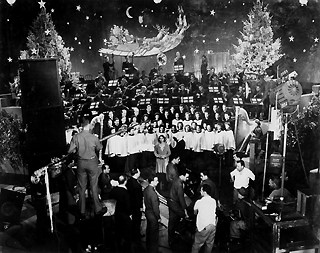|
|
|
Standing next to the camera, with one hand on the seat and a foot on the dolly, Stanley Cortez, ASC works at the Army Signal Corps Photographic Center in Astoria, New York circa 1942-45. The production was a Christmas film, featuring singer Marian Anderson and music conducted by Leopold Stokowsky (both at center of picture). |
At this time, there was a new arrival in the camera department, Stanley Cortez, ASC. We also had some other notable directors of photography, including ASC members Leo Tover, Joseph Biroc and William C. Mellor. These men came in as lieutenants, but by the time Stanley arrived there were no more commissions to be had, so he was a private, like me.
Although I had never done any professional motion picture photography, Stanley was open and friendly with me. I was in awe of his work, as well as his 1942 Academy Award nomination for The Magnificent Ambersons some of the finest black-and-white filming ever done. He was a master of lighting and made great images.
Interestingly, the head of our department was a captain, but not a cinematographer he had worked at 20th Century Fox, which impressed the Army. The second in command, a lieutenant, was a former Hollywood camera operator. Stanley wasn't too happy to have these men as his superiors, particularly as he was a mere private.
Not only did we make training films, but the Army also made entertainment shorts to be seen by the troops overseas. Rank notwithstanding, Stanley was given most of the prestigious assignments. Here's where my story becomes fun, and a tribute to Stanley's talent. Just remember, he had no love for the men heading the camera department.
One day, Stanley was called into our captain's office, and the conversation when something like this:
"Stanley, we'd like you to teach a lighting class for the new recruits."
"Sir, I don't think I can do that."
"Come on now, Stanley, you'd be doing a great service for the Army.
Your reputation will impress these men."
"I'm sorry, but I must refuse."
"Private Cortez, this is an order. You will teach a lighting class, starting tomorrow."
What was Pvt. Cortez to do? If he didn't obey an officer's order he could be court-marshaled.
The next morning, Stanley appeared at a lower-level stage and saw about 50 young recruits seated and waiting for his class. Standing in the rear were the captain and the lieutenant. Stanley instantly knew that they were there only so they themselves could learn something about lighting from an expert. They didn't really care about the recruits who were going overseas to shoot news footage.
Smiling broadly and walking tall, Stanley took center stage. Here's his dialogue as best as I can recall: "Good morning, gentlemen. I'm here to give you pointers on how to light for motion pictures. Now, this is a very broad and complex subject, so it might be best to get right to the heart of the subject by answering your direct questions."
A hand went up and Stanley nodded to a recruit, who asked, "Will you tell us the main difference between high- key and low-key lighting?"
"Ah, a good question," Stanley said. "Well, in high-key lighting you raise the main, or key, light as high as you can, and in low-key lighting you keep it low, near the floor sometimes."
This explanation was factually accurate, but not what the camera department guys wanted to hear. The teaching session was immediately canceled, but the officers didn't give up easily.
Pvt. Cortez usually had the sets he worked on walled in by flats, for privacy. He didn't mind any of his fellow workers stopping by to see how he was lighting, but he wanted to make it a conspicuous effort for the officers to watch. I walked onto his set one day, watched for a few minutes, and noticed something very peculiar. The fill lights (1,000-watt broads) on the left and right sides of the camera were equipped with a red gel on one and a green gel, respectively. We were all shooting black-and-white film in those days and I couldn't see or understand what the colored lights were supposed to be doing. I went up to Stanley and asked, "Stan, I don't understand what the colored fill lights are doing." To which he replied, "Jerry, they're not doing a damn thing to the picture." Gesturing to the two officers standing in the background, he added, "But those nosy bastards over there can't figure it out either and they're too stupid to ask!"
That was Stanley playing tricks again.
After being discharged, I didn't see Stanley again until about 28 years later, in 1972 or '73. I'd made a career move from New York City to Los Angeles, and was attending my very first ASC dinner meeting long after having joined the organization. Stanley was the ASC's president at the time, and following some opening statements, he said, "It's my privilege and it gives me great pleasure to hand a gold 25-year membership card to Gerald Hirschfeld." With a big smile, Stanley shook my hand and said, "Congratulations, Jerry."
These stories are fond remembrances of my friend Stanley Cortez, may he rest in peace. I'll never forget him as a friend, and I'll always admire his work.
— Gerald Hirschfeld, ASC
Mr. Hirschfeld is an outstanding cinematographer in his own right, whose credits include Fail Safe, Diary of a Mad Housewife, Young Frankenstein and My Favorite Year.
